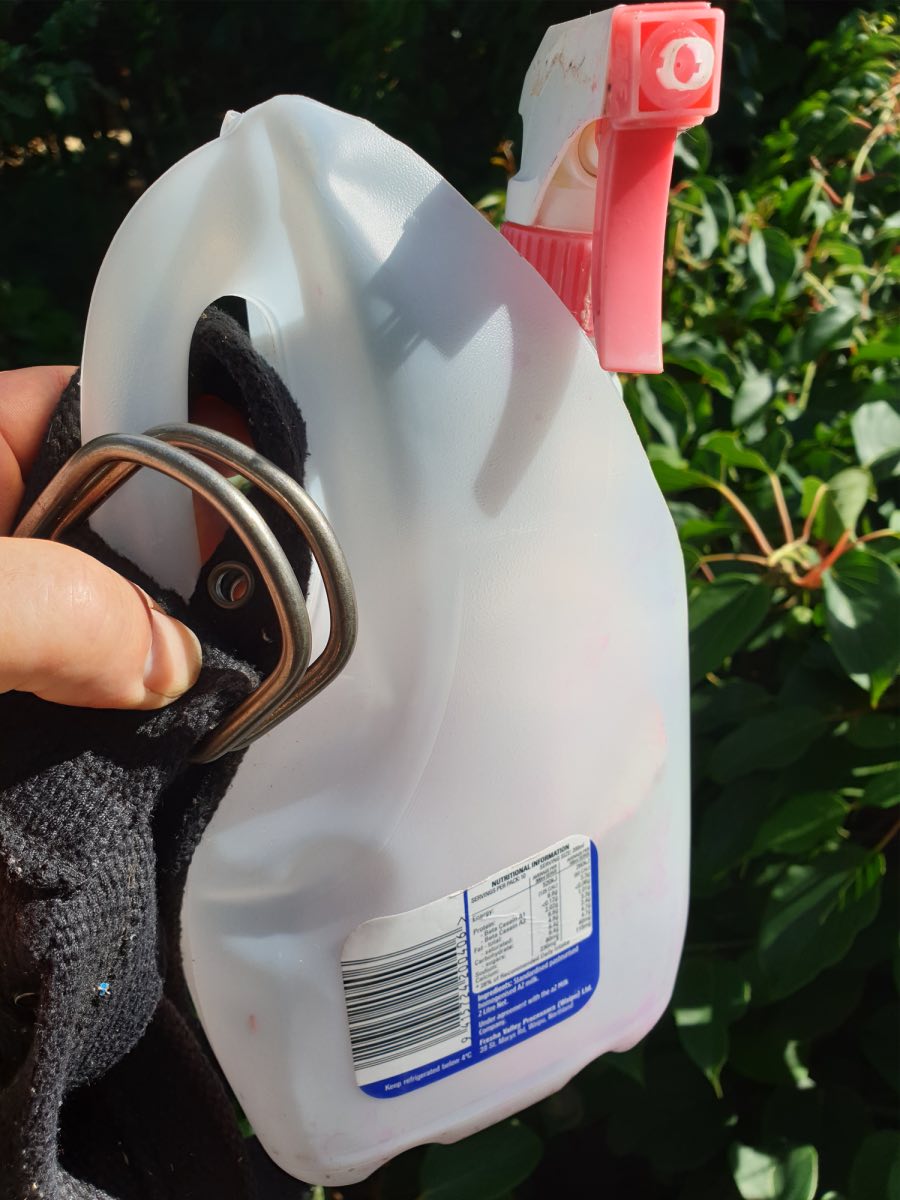NZFFA Member Blogs
Member Blogs
Recent blogs:
Spray releasing young trees with glyphosate
Dean Satchell's blogFriday, December 23, 2022
I'm often been questioned about spray releasing diverse species when helping landowners with the early stages of forest establishment. Spray releasing methods for radiata pine are well established and you can spray right over the top of them with the right herbicide. But what about "alternative" exotics and native species? The issue is that the efficacy of each herbicide tends to be species dependent, so it's risky to use herbicide around young trees unless there is good knowledge on its safety. The stakes are high and failure can be catastrophic.
Because there are so many tree species and so many herbicides, spray releasing can get complicated. It is also perhaps the most critically important part to get right with growing trees. Because I like to keep things simple but effective, I use glyphosate. Of course glyphosate kills just about any plant it comes into contact with, but there is a simple method for its safe application to release young trees from their weed competition. The advantage with a broad spectrum herbicide such as glyphosate is that its simple to get right and kill all the weeds surrounding your trees. Of course, if there is a herbicide that you know is safe to spray around your trees and kills all your problem weeds, then just go with that one and ignore my advice.
Firstly, the spray mix needs to be right. For every ten litres of spray mix I use 100ml glyphosate 360. The "360" bit is the concentration of glyphosate, meaning that there is 360g/litre of the active ingrediant (i.e. glyphosate). If the label says the concentration is different then adjust the mix accordingly.
Next, 20mls of penetrant should be added per ten litres of spray mix. This is important to kill legumes such as clover and gorse and other hard-to-kill weeds.
Lastly, spray dye is essential. I just use a splash for every ten litres, enough to see where you've applied the spray. This is not only because it's important to know where you've already sprayed, but also to alert you where you accidently get spray on your trees.
Then, the most important kit to prepare before you start is the "spray guard". This is to stop spray drifting onto your trees. This is essentail and I've demonstrated what I use in the video below.
Spraying a one metre circle around your trees seems to be standard practice. Best in late spring or early summer. Too late and your trees get lost or just don't grow because of root competition.
A simple but essential piece of equipment is a small spray bottle of water. Keep it on you at all times in case of accidental contact between glyphosate and tree. The glyphosate must be washed off immediately, because the penetrant quickly draws it into the plant.

Never spray if there is rain or too much wind. Keep the pressure low, don't pump the backpack up too much because you'll get more spray drift which is risky for both yourself and the plant. Apparently glyphosate isn't good for humans so I like to use leather gloves over disposable latex gloves and good trousers and gumboots to ensure spray doesn't get to the skin.
I take no responsibility for the advice I give here, it works for me but if you're careless then things won't go well. Because glyphosate is a systemic herbicide, it can translocate through the plant from one point of contact and kill it. You don't want to get it on your tree. That said, it only seems to soak into green leaves, so doesn't appear to cause issues from soil or stem contact at the base of the tree.
Diversifying our productive forests to build sector resilience
Dean Satchell's blogWednesday, September 07, 2022
Throughout the media one clear message prevails about planting trees and forests: Either plant pines, or plant natives. Apparently those are the only options. Forest Owners have no reason to counter that, growing pine after all is business as usual. One species and one wood, where “wood” and “radiata” are interchangeable terms and serve both the forest and wood processing industries well.
The Industry Transformation Plan, on the other hand, is about innovation that leads to a prosperous future industry. Wood is as diverse as the tree species that produce it, and this was identified by the advisory group as a clear opportunity industry should not ignore. Although diversifying into specialty timbers does challenge that “business as usual” model, the opportunity for industry to mitigate both biological and business risk is real and significant.
The other reality is that the forest industry has, rightly or wrongly, earned a negative and highly-charged reputation for being an unsustainable pine monoculture. That reputation will continue to erode the forest industries social licence to operate. Everyone knows that pines poison the soil and deplete biodiversity. Well, that’s what I’m being told all the time in my role as land management advisor. Just ask any farmer or city dweller. Whether right or wrong, people hear what they want to hear, not necessarily what is fact. The public, as holders of the forest industries social licence to operate, demand genuine narrative and tangible change where they see this is required, so distrust glossy promotional campaigns because these are perceived to disguise business as usual.
Add to this the Climate Change Commission jumping aboard Dame Anne Salmond’s vision of vast areas on New Zealand covered in planted native forests, to counter the villain monoculture pine industry. Let’s not kid ourselves, the economics of growing native plantations for timber don’t stack up, the Forest Service figured that out early last century. Anyway, reinventing that wheel would require significant research investment, with no guarantees of returns. More importantly, before deploying native timber plantations at scale, decades of trials would be necessary to inform productivity models.
The ITP working group did our best to get this through to a native-indoctrinated Te Uru Rākau. Unfortunately that bandwagon is well rolling, in my view prematurely gaining momentum and with no thought being given to the circumstances where land should be retired from production. In my opinion FOA haven’t helped the situation by partnering with Te Uru Rākau in their “It’s time for wood” campaign that centres around regional economic development based on “indigenous trees and their timber’s appeal as an alternative to importing tropical hardwoods”. This sets the stage for “them and us” (heroes and villains), and a lost opportunity of epic proportions unless industry steers a new path to diversify our productive species mix. The handbrake as I see it is corporate sector motivation for change, and at the scale required for success.
To shed the evil reputation of a “monoculture” industry, serious investment in diverse species for wood production is required, in partnership with government. The Specialty Wood Products programme has made good progress and the knowledge gaps are being filled. We just need to refocus investment and understand that levies accrued from radiata logs don’t necessarily need to go back into radiata, but instead where strategic industry investment is most needed. The R&D deck has been stacked against alternatives for 80 years, so no wonder preconceptions abound within the forest sector. Despite this, there are good initiatives being undertaken to commercialise redwoods, cypress and eucalypts, fast-growing species not only offering diverse wood products, but also opening the door for continuous cover forestry on steep slopes.
If, as the forest industry, we were to seriously invest in exotic species that produce high-value specialty timber, not only would we open new market opportunities while addressing species concentration risk, but done right we’d also transform our social license to operate. If industry doesn’t take that initiative then the politicians will fill the void with vast native afforestation of pastoral hill country, to satisfy their climate response agenda and the publics thirst for diversity. The promise might be that native trees produce high-value timber, but my experience says otherwise. Native canopy species are difficult enough to establish successfully in pasture, but worse because their ecology is to emerge through pioneer scrub species, producing straight stems requires extremely complex silvicultural systems that are currently only being imagined. But politicians don’t always get reality.
Shade tolerant, coppicing species like redwoods and eucalypts mitigate landslide risk under a continuous cover regime, so what level of slope is too great for production forestry? Rotation forests have a much lower slope threshold, implying that land deemed unsuitable for clearfell has nil capital value. Under that scenario, are the higher harvesting costs of single tree extraction justified for high-value timber species? Without knowing the answer to that, forest owners only have assumptions when weighing risk to replant orange and red zone land against retirement. Pastoral land owners consider only two tree planting options for their hills, rotation pine or native retirement, with no species or landslide risk information. Becoming informed would begin the paradigm shift, but that also means progressive thinking. My favourite quote, "Paradigms fall slowly, from the weight of repeated failure", reflects only the lack of industry imagination.
It’s achievable to provide sustainable wood production and biodiverse, rich outcomes for society by diversifying the productive species mix. But an industry vision and a commitment for action is required to bring government along for the ride, with both parties serious about delivering the goods. The small forest grower is already there.
Disclaimer: Personal views expressed in this blog are those of the writers and do not necessarily represent those of the NZ Farm Forestry Association.

 Specialty Timbers New Zealand
Specialty Timbers New Zealand